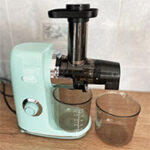The Hazel Quinn slow juicer is advertised as being the first in the world to have a truly filter-free design and, as a consequence, the user should have less trouble cleaning it, with no real negative impact on the quality of the juice.
| Hazel Quinn Slow Juicer | |
|---|---|
| Hazelquinn.com | Check Product |
| Amazon.com | Check Product |
And I understand that this is the manufacturer’s way of standing out of the crowd, especially considering the price tag of the device, but the question is whether you should consider a budget slow juicer to being with? While I would always opt for the premium brands that have proven their worth over time, not everyone can afford the expensive options, and college students would most likely appreciate the relatively compact design of the Hazel Quinn slow juicer, as well as it’s chic look.
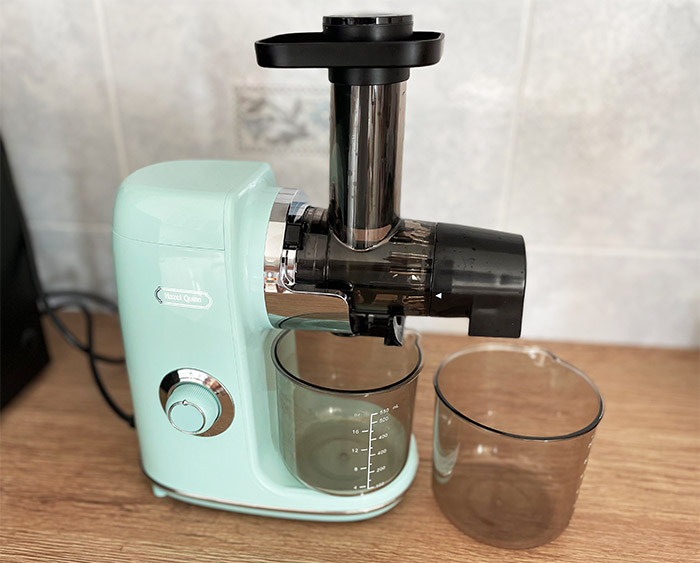
It’s a bit on the retro side, but it will fit in with most types of kitchen furniture. Some focus has also been put on a simple installation of parts, as well as the aforementioned simplified cleaning process, so, as we will soon see, the developers took some interesting decisions when they built the Hazel Quinn slow juicer (and yes, not all are that good). That being said, let’s check out the device and see if it manages to go above its similarly-priced peers and whether it may be better to invest in something more expensive in the long run.
Design and Build Quality
It’s pretty obvious that the Hazel Quinn slow juicer went for a retro look and the mint green color that covers the main body of the device is in tune with the newer kitchen design trends. There are also some faux-chrome elements, but I could feel no metal, it’s all variations of plastic.
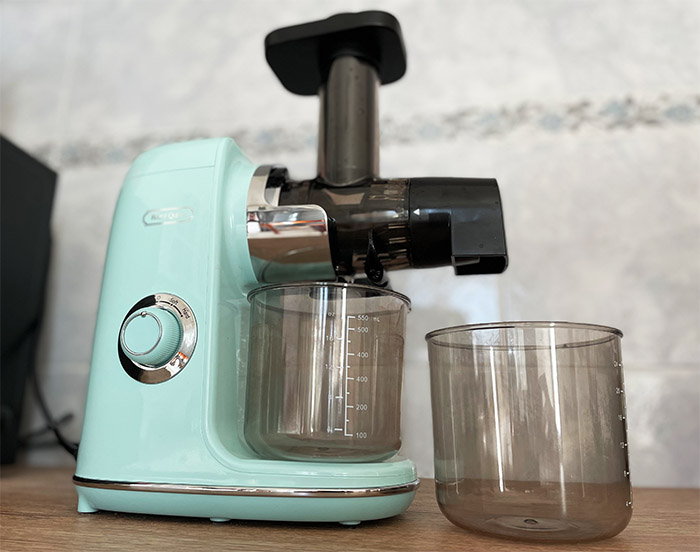
In terms of size, the slow juicer is 9.8 inches-tall (25.0cm) and its footprint is 12.2 x 5.5 inches (31.0 x 14.0cm), so, while not that big, it will still take some space from your counter top. Out of the box, the Hazel Quinn slow juicer comes with the food processing unit detached from the main body, but with all its elements already installed. I forgot to mention that the food processing unit and most of its other elements are semi-transparent, so you can see the food crushing process while it’s happening.
The pusher is matte black, as well as the hopper and the outlet. The Hazel Quinn slow juicer comes with two containers, a larger one for the crunched food, the other for the juice and yes, one is slightly larger than the other. There are two things that I liked about the containers, one is that both have measurements and second is that it’s easy to pour liquids out of them. What I didn’t like was that both are made of BPA-free plastic – glass or stainless steel would have been a better choice, although I understand the budget restraints.
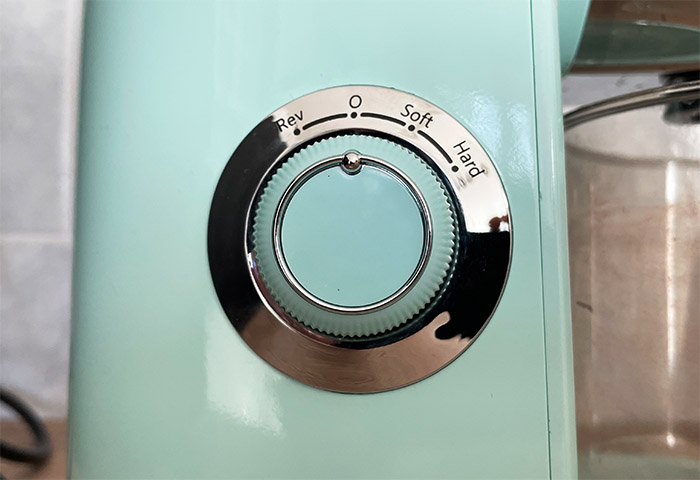
Also, the larger container could have been a bit taller to better accommodate the crushed fruits and vegetables. Now let’s have a closer look at the base unit. On its side, we can see the larger circular button which has four states. By default, it’s going to be set to 0 and, depending on the type of fruit or vegetable is being crushed, you can set the slow juicer to Soft or Hard. There is a third setting called Reverse which is useful in case the Hazel Quinn slow juicer gets stuck and need to force some pieces backwards.
On the bottom, there are six silicone feet to keep the device into place (the slow juicer is heavy enough to remain steady into place). Next to the feet there are two main openings, one for the fan and the other for the air inlet. Now let’s talk a bit more in depth about the food processing unit and its components / accessories. If we don’t take into account the hopper and the pusher, the unit comes already fully assembled, but it is possible to take out the outlet by rotating it clockwise (you may need to apply a bit of force to do so). Inside the outlet, we can see that there is a fairly small hole and a pattern that matches the one on the food processing unit.
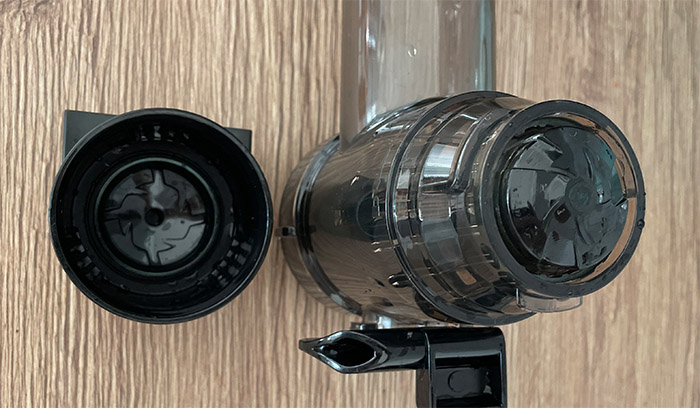
I suppose the hole should be enough to push out most types of fruit and vegetables, but I am very sure that it will have trouble handling celery and other similar fibrous vegetables. Some other manufacturers have included additional means of crushing the food one last time before pushing it out, but this is not really an option on the Hazel Quinn slow juicer. Moving forward, we get to the juicing screw and the auger cover, and both seem to be made out of some type of plastic with a metallic rod holding crossing within both parts.
The blade of the auger is interestingly-shaped and we will soon see how well it manages to crush food. But there is one thing that I need to mention about the food processing unit. At the bottom, where the juice needs to come out, the manufacturer has added a cover which needs to be opened every time the juicer is used and, although it works, it is a bit of a strange approach.
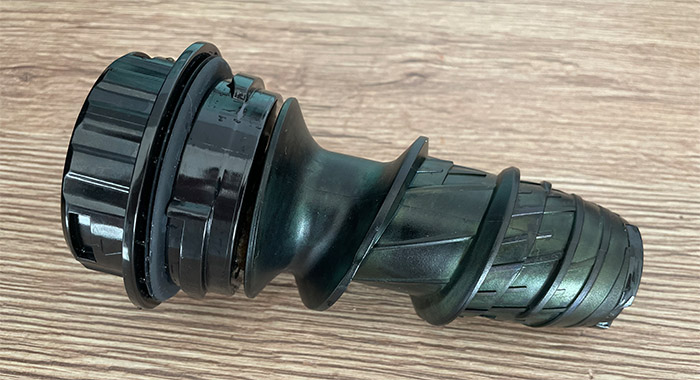
In any case, what’s interesting is that there doesn’t seem to be a filter (screen) through which the juice needs to go through and that’s where the whole filter-free advertisement comes from. I mean, there is a sort of filter embedded within the plastic unit, but it’s non-removable and it seems to be easier to clean that the slow juicer that do use a separate filter.
Before moving forward, does the Hazel Quinn slow juicer use universal parts that can be easily replaced when the expected wear happens? No, everything needs to come form the manufacturer and it is possible that in the near future some parts will not be available at all (such as the case with most other budget-friendly devices, unfortunately).
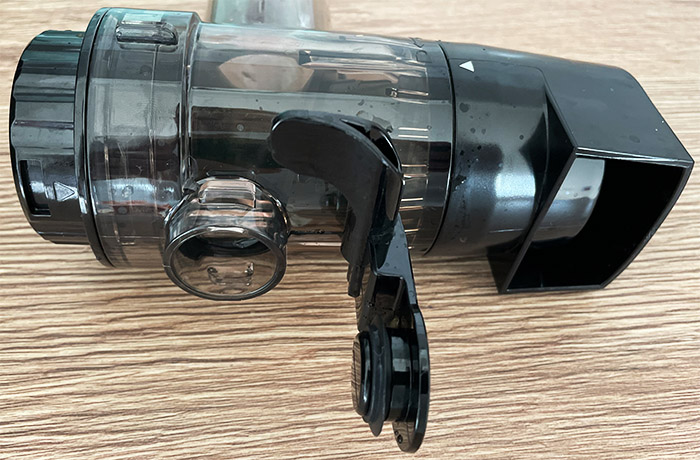
Hazel Quinn Slow Juicer in action
Before anything else, I was curious about how noisy the Hazel Quinn slow juicer is, especially on the Soft setting. There are some surprisingly quiet slow juicer out there, such as the Omega VSJ843 or the Sana 727, but it’s necessary to also have a look at the price tag, because these two cost a lot more than the Hazel Quinn slow juicer (the latter is almost ten times more expensive at the moment of writing). After starting up the Hazel Quinn slow juicer, it’s pretty obvious that we are dealing with a loud device.
I measured about 64dB using the Soft setting, so it’s indeed noisy. Now let’s see how the device handles hard and soft vegetables / fruits. Carrots are an easy way to check if a slow juicer is able to properly crush hard vegetables, so I set the Hazel Quinn slow juicer to the Hard mode and then I fed it roughly 2.5 pounds of carrots (a bit over 1kg). And, as you can see from the video, the slow juicer will push the juice to the smaller container, while the crushed remains go on the front, into the larger container. There’s nothing out of the ordinary with the entire process, so let’s have a look at the end result.
While more than 90% of the cup was pulp-free, the last 10 percent of the cup is filled with thicker juice and at the bottom, the pulp gets way more noticeable. Not even the best slow juicers out there are capable to produce perfectly pulp-free juice, and, while the Hazel Quinn slow juicer does perform better than its similarly-priced peers, it isn’t as good as the more expensive models out there. Taking into account the price, I would say that it is a bit above average when crushing hard vegetables and fruit.
Next, I wanted to see how well it could handle apples and things got interesting. I prepared two apples and I set the juicer to work in Soft mode. As you can see, the leftover pulp was decently dry and I could barely squeeze some remaining juice out of it. At the same time, the juice had a lot of foam and, due to the smaller quantity, I could immediately tell that there was a very much noticeable quantity of pulp into the blend. I suppose that the reason why it’s so ‘pulpy’ is due to the embedded screen (filter) which has the openings wide enough for more apple pulp to slip in. So, for soft foods, the Hazel Quinn slow juicer is closer to average than how it was when I crushed hard vegetables.
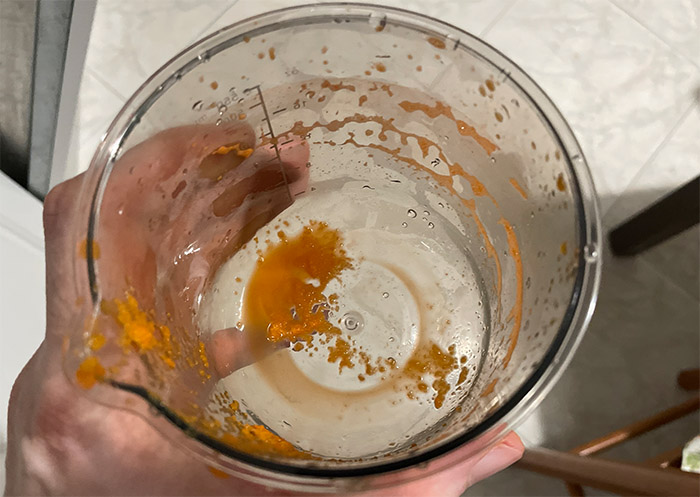
How easy it is to clean?
The whole idea behind the screen-less design was to make the cleaning process an absolute breeze, so can the Hazel Quinn slow juicer manage to rise up to the expectations? You still have to take apart each piece and thoroughly clean it, but yes, you do get one less part to clean and it’s usually the most tedious one: the screen. So the Hazel Quinn slow juicer is indeed easier to clean than other similar devices. Also, be aware that the main body of the device (which contains all the electronic parts) should only be cleaned by a cloth and should not be submerged under water. Anything else, you can either wash by hand or put them into a dishwasher.
The Conclusion
Considering the price tag of the Hazel Quinn slow juicer, we are dealing with a surprisingly capable device, managing to crush both soft and hard fruits and vegetables. And sure, some pulp will end up in the juice, but it’s way less than what I expected at this price point. The device is not silent at all, regardless of the mode, but the screen-less design does work in its favor considering that it’s indeed easier to clean than other slow juicers. So, overall, I do recommend it if you’re looking for a budget-friendly option.

Mark is a graduate in Computer Science, having gathered valuable experience over the years working in IT as a programmer. Mark is also the main tech writer for MBReviews.com, covering not only his passion, the networking devices, but also other cool electronic gadgets that you may find useful for your every day life.

